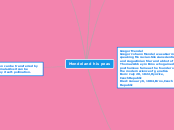Reproduction in plants
Fun facts!
■The world's biggest seed is the coco-de-mer nut, which can weigh up to 20kg (45lb).
•Butterflies attach their eggs to leaves with a special glue
•Butterflies taste food by standing on top of it! Their taste receptors are in their feet unlike humans who have most on their tongue
•One bushel of corn will sweeten more than 400 cans of pop.
•Onions contain a mild antibiotic that fights infections, soothes burns, tames bee stings and relieves the itch of athletes foot.
•Asparagus is a member of the lily family, which also includes onions, leeks, and garlic
•Arrowroot, an antidote for poisoned arrows, is used as a thickener in cooking (so if you ever get shot with a poison arrow, do not go to a doctor, look in your kitchen cabinet.
Male Parts
Anther
Storing and producing pollen
Filament
Supports the anther
Female Parts
Ovary
Responsible for housing the eggs
Style
Supports the stigma
Stigma
Captures the pollen
Main topic
Stages:
Germination
Means to sprout or grow
Only possible if the seed lands in a place with sufficient air, water and the right temperature.
Dispersal
Juicy or frangrant
e.g. hibiscus
Dry and light/ Wing-like structures or hairs
e.g. Dandelion
Splitting
Ripen, dry up and split open
e.g. rubber tree
Water
e.g. coconut tree
Waterproof covering/Fibrous husk
Fertlisation
Step 1: Upon landing on the stigma, each pollen grain produces a tube that grows down the style to the ovules in the ovary.
Step 2: When the pollen tube reaches the ovule, fertilisation takes place.
Meeting of the male reproductive cell and the female reproductive cell.
Process
Formation of fruit and seeds
1) Petals will wither and drop off
2) Ovary swollens and develops into a fruit
3) The ovules become seeds
Pollination
Wind
Feathery stigmas
Small and dull petals, no sweet smell nor nectar
Animals
Insects/ small animals
Petals must be colourful, big, bright, have a pleasant smell and nectar
Pollen grains are usually sticky so as to stick onto the insect's body









